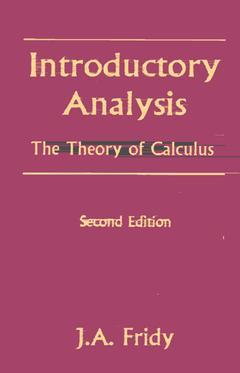Description
Introductory Analysis (2nd Ed.)
The Theory of Calculus
Author: Fridy John A.
Language: English
Subject for Introductory Analysis:
335 p. · 15x22.8 cm · Hardback
Out of Print
Description
/li>Contents
/li>Readership
/li>Comment
/li>
Introduction: Mathematical Statements and Proofs Ordering of the Real Numbers Sequence Limits Completeness of the Real Numbers Continuous Functions Consequences of Continuity The Derivative The Riemann Integral Improper Integrals Infinite Series The Riemann-Stieltjes Integral Function Sequences Power Series Metric Spaces and Euclidean Spaces Continuous Transformations Differential Calculus in Euclidean Spaces Area and Integration in E²
Appendix A. Mathematical Induction B. Countable and Uncountable Sets C. Infinite Products
- Bases most of the various limit concepts on sequential limits, which is done first
- Defines function limits by first developing the notion of continuity (with a sequential limit characterization)
- Contains a thorough development of the Riemann integral, improper integrals (including sections on the gamma function and the Laplace transform), and the Stieltjes integral
- Presents general metric space topology in juxtaposition with Euclidean spaces to ease the transition from the concrete setting to the abstract
New to This Edition
- Contains new Exercises throughout
- Provides a simple definition of subsequence
- Contains more information on function limits and L'Hospital's Rule
- Provides clearer proofs about rational numbers and the integrals of Riemann and Stieltjes
- Presents an appendix lists all mathematicians named in the text
- Gives a glossary of symbols




